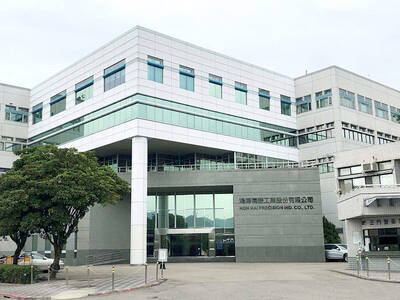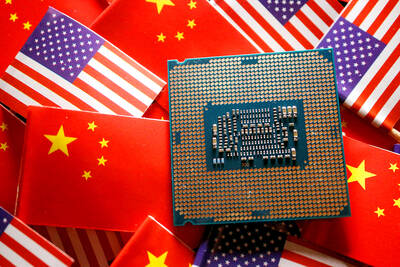Google Inc’s self-driven cars will soon be appearing on Nevada roads after the state’s Department of Motor Vehicles (DMV) approved on Monday the nation’s first autonomous vehicle license.
The move came after officials rode along on drives on highways, in Carson City neighborhoods and along the Las Vegas Strip, the Nevada DMV said in a statement.
The Nevada legislature last year authorized self-driven cars for the state’s roads, the first such law in the US. That law went into effect on March 1.

Photo: Reuters
Google’s self-driven cars rely on video cameras, radar sensors, lasers and a database of information collected from manually driven cars to help navigate, according to the company.
The DMV licensed a Toyota Prius that Google modified with its experimental driverless technology, developed by Stanford professor and Google vice president Sebastian Thrun.
Google’s self-driving cars have crossed the Golden Gate Bridge and driven along the picturesque Pacific Coast Highway, according to the company.
Autonomous vehicles are the “car of the future,” Nevada DMV director Bruce Breslow said in a statement. The state also has plans to eventually license autonomous vehicles owned by the members of the public, the DMV said.
Legislation to regulate autonomous cars is being considered in other states, including Google’s home state of California.
“The vast majority of vehicle accidents are due to human error. Through the use of computers, sensors and other systems, an autonomous vehicle is capable of analyzing the driving environment more quickly and operating the vehicle more safely,” California state Senator Alex Padilla said in March when he introduced that state’s autonomous car legislation.
Other car companies are also seeking self-driven car licenses in Nevada, the DMV said.
Separately, Toyota Motor Corp unveiled on Monday what it says is the first all-electric sports utility vehicle (SUV) on the market, a version of its popular RAV4 with a top range of 161km and minimum six-hour charge time.
The car will be sold initially only in California with a base price of US$49,800 and the Japanese car company hopes to sell a relatively modest 2,600 units over the next three years.
Toyota Motor Sales USA executive Bob Carter said the company believes the car would “attract sophisticated early technology adopters, much like the first-generation Prius,” Toyota’s pioneering hybrid car launched 15 years ago.
“It’s all about blending the best of two worlds ... The all-new RAV4 EV marries the efficiency of an EV with the versatility of a small SUV — in fact, it is the only all-electric SUV on the market,” he added.
The car, which costs more than twice as much as the gas version of the RAV4 and would have difficulties with out-of-town driving for any distance, may struggle to find a mass appeal.
“It’s designed for consumers who prioritize the environment and appreciate performance,” Carter said, adding that the new car would go on sale later this summer in San Francisco, Los Angeles, Orange County and San Diego.
“We look forward to seeing how the market responds,” he added, unveiling the car at the 26th annual Electric Vehicle Symposium in Los Angeles.

Shares in Taiwan closed at a new high yesterday, the first trading day of the new year, as contract chipmaker Taiwan Semiconductor Manufacturing Co (TSMC, 台積電) continued to break records amid an artificial intelligence (AI) boom, dealers said. The TAIEX closed up 386.21 points, or 1.33 percent, at 29,349.81, with turnover totaling NT$648.844 billion (US$20.65 billion). “Judging from a stronger Taiwan dollar against the US dollar, I think foreign institutional investors returned from the holidays and brought funds into the local market,” Concord Securities Co (康和證券) analyst Kerry Huang (黃志祺) said. “Foreign investors just rebuilt their positions with TSMC as their top target,

REVENUE PERFORMANCE: Cloud and network products, and electronic components saw strong increases, while smart consumer electronics and computing products fell Hon Hai Precision Industry Co (鴻海精密) yesterday posted 26.51 percent quarterly growth in revenue for last quarter to NT$2.6 trillion (US$82.44 billion), the strongest on record for the period and above expectations, but the company forecast a slight revenue dip this quarter due to seasonal factors. On an annual basis, revenue last quarter grew 22.07 percent, the company said. Analysts on average estimated about NT$2.4 trillion increase. Hon Hai, which assembles servers for Nvidia Corp and iPhones for Apple Inc, is expanding its capacity in the US, adding artificial intelligence (AI) server production in Wisconsin and Texas, where it operates established campuses. This

Nvidia Corp chief executive officer Jensen Huang (黃仁勳) on Monday introduced the company’s latest supercomputer platform, featuring six new chips made by Taiwan Semiconductor Manufacturing Co (TSMC, 台積電), saying that it is now “in full production.” “If Vera Rubin is going to be in time for this year, it must be in production by now, and so, today I can tell you that Vera Rubin is in full production,” Huang said during his keynote speech at CES in Las Vegas. The rollout of six concurrent chips for Vera Rubin — the company’s next-generation artificial intelligence (AI) computing platform — marks a strategic

US President Donald Trump on Friday blocked US photonics firm HieFo Corp’s US$3 million acquisition of assets in New Jersey-based aerospace and defense specialist Emcore Corp, citing national security and China-related concerns. In an order released by the White House, Trump said HieFo was “controlled by a citizen of the People’s Republic of China” and that its 2024 acquisition of Emcore’s businesses led the US president to believe that it might “take action that threatens to impair the national security of the United States.” The order did not name the person or detail Trump’s concerns. “The Transaction is hereby prohibited,”